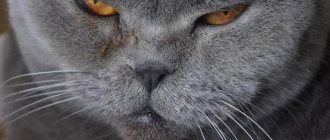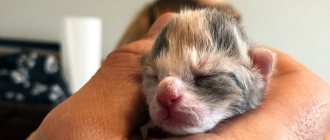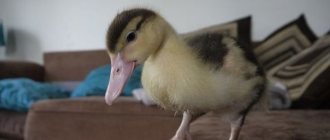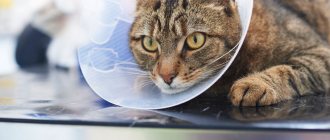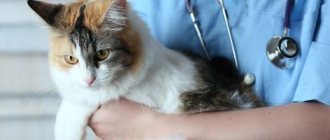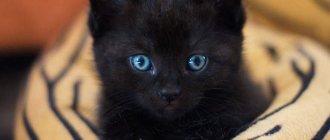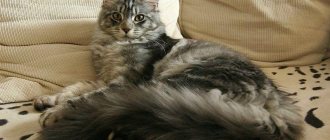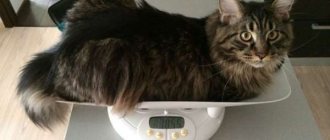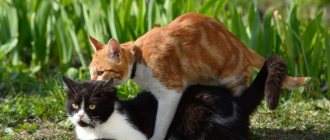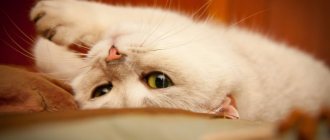As pet owners, we want to witness our cats' life milestones. Kittens grow quickly in the first months of life, but the question is: when does a kitten become a cat?
A kitten is considered an adult cat when it reaches one year of age . Time flies and before you know it, you already have an adult cat at home. Cats develop physically at a rapid rate, but it takes a lot of patience and care before your kitten becomes a full-fledged cat.
What to do before your kitten becomes a cat
Before your cat becomes an adult, she must go through the following stages:
- First week . In the first week of life, your kitten will be small, weak, and dependent on its mother for survival. It will be breastfeeding and his eyes will be slightly open. At this stage, your kitten will gain between 10 and 30 grams of weight per day, so she should continue to nurse.
- First month . By the time your kitten is a month old, he will be able to play and walk. It would be best if you started socializing the kitten so that he grows up to be a happy and sociable cat.
- The first vaccines . Your kitten will receive its first vaccinations between 8 and 10 weeks of age. Subsequent vaccinations will be given 2-4 weeks after the first. This is an important step to protect your kitten from infections and fatal health problems.
© shutterstock
When your kitten turns one year old, he will no longer be a kitten. He will become an adult cat that will become bigger and bolder as he enters adolescence. Your newly grown cat will try to get her way and break your rules. Although your cat is no longer a kitten, she will still exhibit cat-like attitude from time to time.
As your kitten gets older and larger, its nutritional needs also change. You can always consult your veterinarian about the dietary needs of your growing cat.
How to Deal With Your Kitten's Adolescence
When your kitten turns one year old, he will enter the teenage phase. Just like with people, this can be a difficult time for parents. Teenage cats will howl, constantly throw, scratch and try to get their way.
The once adorable kitten will become sassy and difficult to deal with. But before you give up, there is always a workaround for such situations.
The kitten becoming a cat will have a burst of energy. They will try to explore everything, especially nature. To make this stage more tolerable, I recommend doing the following:
- Consider spaying/neutering . A cat can be spayed even before it turns one year old. So instead of waiting for your kitten to become stubborn, it's best to have her spayed or neutered to curb the harmful effects of sexual activity. Remember that females in the heat of love scream and make noises, while males often run off in search of a female.
- Learn to channel your cat's energy . Most cats are born balls of energy. Instead of trying to limit your cat's activities, you can channel that energy into less destructive habits. Invest in a post-it note, cat tree, puzzles, and other interactive toys to keep your kitty occupied.
- Be firm with the rules . Teenage cats will try to test your limits. If your kitten uses your skin as a toy, make sure there are consequences for it. This could be a spray of water or a game over. Use safe and non-violent methods to discipline your pet. Thanks to this, he will not become neurotic and alienated.
When does a kitten stop growing?
Kittens will have a rapidly growing body from the day they are born until the first six months of life. After this, your cat's growth will slow down. Most cats reach their full size by one year of age, the same time they become adults. However, this depends on the breed and health of the kitten.
Even if a cat reaches its full size, this does not mean that it will behave like an adult. Most cats will be cheeky and teenage-like in the first 8 to 12 months of their lives.
Please note that nutrition plays an important role in a kitten reaching its full body size. You must provide your kitten with a balanced diet so that he grows up strong and healthy. However, it would be best if you monitor your kitten's weight, as some breeds have a high risk of obesity.
Obesity is very unhealthy, especially for cats because they love to climb and jump off surfaces. Excess weight will crush your kitten's joints and increase the risk of developing orthopedic problems.
Factors influencing growth
Gender also affects the size of the animal, for example, the muzzles of females are almost always narrower and more elongated than those of cats. If the cat's face stops growing, it means that the skeleton is formed, the head and shoulder width will remain at this level and will not grow any further. As a rule, this occurs by 2 years.
Internal factors
The age at which cats grow is not the only factor in an animal’s growth. There are external and internal factors influencing the development of an animal. The main internal factor is breed. Representatives of large breeds grow longer than miniature ones.
Table: average sizes for different breeds
| Breed | Weight Limit |
| Maine Coon | 18 kg |
| Persian | 6.8 kg |
| Kurilian Bobtail | 5–6 kg |
| British Shorthair | 8 kg |
| American Curl | 4–5 kg |
| Russian blue | 7 kg |
| Egyptian Mau | 7 kg |
| Sphinx | 6 kg |
| Scottish lop-eared | 6 kg |
| Siamese | 5 kg |
| Snow shu | 5–6 kg |
| Munchkin | 3–4 kg |
Munchkin cats have short legs, which makes them appear short.
Heredity can also affect the size of the animal. Kittens, like all children, look like their parents. Slender and miniature cats rarely give birth to “chubby” kittens. Such cubs mature slowly. Conversely, the offspring of large females grow rapidly, regularly gaining weight.
In fact, she looks funny - her head is small, her pug-like features are small, and her body is just very big. Somehow disproportionate from the outside. But we saw her parents - her dad is the same - a big belly and a small head.
queenan, owner of a “fat” kitten
https://eva.ru/static/forums/30/2005_9/423431.html
Another internal factor is endocrine imbalance, which affects how old cats grow. Most often it occurs after the use of hormonal drugs (for example, there was treatment with hormones). In addition, hormonal imbalance can occur due to improper functioning of the endocrine system (disturbances in the functioning of the adrenal glands, reproductive system, thyroid gland, etc.). Sometimes an active pet of a medium-sized breed grows very large, despite the fact that the parents were miniature.
In Queensland (Australia) there lived a cat named Himmi. The cat's owner was Thomas Wise. Himmi lived a little over 10 years and reached a weight of 21 kg. The cat's abdominal circumference was 84 cm. Himmi was about 100 cm long (from his nose to the tip of his tail). Himmi was recognized as the fattest cat in the world. It was difficult for the cat to walk due to his height and size, and Thomas had to carry him in a special wheelbarrow. Himmi died in 1968.
Some cats grow so big that it is difficult for humans to hold them in their hands.
External factors
In addition to internal factors influencing growth, there are also external ones. The most significant external factor is the animal’s nutrition. If a cat is fed high-quality, balanced food, then it grows up to be active, athletic and moderately well-fed. With improper nutrition, a cat's growth can slow down or speed up. Nutrition affects not only the functioning of the gastrointestinal tract, but also the growth of the musculoskeletal system.
I feed my cat homemade food, but I also try to make sure she gets all the vitamins and nutrients she needs. Cats love fish very much (it is healthy due to its phosphorus content), so for them I buy fish separately (so that it is not too fatty). It is also important that your pet receives calcium. A lot of calcium is found in dairy and fermented milk products.
In addition, the following living conditions contribute to the proper growth and development of the animal:
- First, the space for the animal must be appropriate for the size of the animal. After all, a kitten will not grow into a big cat if it lives in a shoebox.
Living conditions are important for the growth of a cat: you need to choose a place of suitable size for him
- Secondly, you need to monitor sanitary and hygienic conditions. Your pet can get sick if it eats from unwashed dishes, goes into a dirty litter box, etc. And any disease will certainly affect the development of the animal’s body. Unsuitable living conditions can lead to helminthiasis or other types of parasitic diseases. If the coat is not properly cared for, the animal may be attacked by fleas. Such a cat will suffer, constantly itch and may get sick. An animal tormented by worms and fleas cannot develop normally.
Sterilization can also lead to changes. Everyone knows that sterilized cats gain weight and become lazy. Some owners even like it. But, if the fluffy gains weight, then he suffers due to hormonal changes. Indeed, in addition to weight gain, the cat can continue to increase in size (for example, bones). In addition, growth impairment can occur due to stress. So, if a cat’s body begins to produce hormones that it is not used to, this can lead to changes in development.
Video: how to properly feed a neutered cat
When does a cat calm down?
Cats will become adults when they are one year old. However, it will only be after 14 months that she will begin to calm down. Kittens and young cats are playful, but the teenage phase will make them restless and adventurous.
However, some cats take longer to soften their kitten personality. Some breeds do not mature until they are two years old. However, this depends on the breed of your cat, as some remain energetic throughout most of their young life.
© shutterstock
Unlike dogs, cats do not calm down because most felines are naturally energetic. This is their trait, and it will disappear only when the cat reaches an older age. However, some cats are more adventurous than others, regardless of age.
How do you know how big a kitten will grow?
Cat owners often ask how big their kittens will grow. This is a common problem for those who have adopted their cats. Although it may be difficult to tell, a veterinarian can help paint a better picture.
In most cats, body growth slows down after six months and reaches its full size after a year. However, large breeds such as Ragdolls and Maine Coons will continue to grow after the first 12 months of life.
To give you an idea of how big your kitten will grow, most cats will weigh twice their original size by the time they reach four months. If your cat is a big kitten, she will likely be larger than usual. The size formula will be:
Your kitten's weight at 16 weeks x 2 = adult/full size weight.
This calculation will give you at least a margin of error of plus or minus 10% of your cat's total weight.
To what age do cats of different breeds grow?
Most pets reach adult size by puberty. But growing up means not only an increase in weight and size - the formation of all organs and systems of the pet is taken into account.
When does a cat become an adult?
In recent years, cats' ages have been revised to provide a clearer and more accurate assessment of their physical health. Currently, cats are considered seniors when they reach 11 years of age. Meanwhile, 12 to 14 years old are older cats. If your cat managed to live more than 14 years, she would be called a super-old lady.
From a kitten, your cat will become an adult and then a senior citizen. It's very similar to human life, albeit at a faster pace.
The first two years of your cat's life are equivalent to about 24 human years. After that, each cat year is equal to four human years.
As your cat ages, she will become less active due to pain associated with aging. Older cats will also have a reduced ability to taste and smell food, so they will appear to be picky. Your cat's nutritional needs will also change depending on its health.
Problems of an aging animal
Caring for an old cat involves, first of all, paying attention to its health. His chronic diseases worsen and new age-related symptoms appear. You need to visit the veterinary clinic more often and have your blood tested for preventive purposes. Sick pets should receive the necessary and timely treatment. This will reduce the problems associated with old age.
It is believed that if an old cat eats a lot, this indicates a lack of attention.

